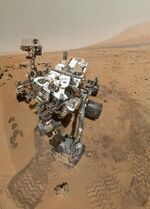Astronomy:Kepler-36b
From HandWiki
Short description: Suspected lava-like super-Earth orbiting Kepler-36
| Discovery | |
|---|---|
| Discovery date | 2012 |
| Transit (Kepler Mission) | |
| Orbital characteristics | |
| 0.1153 AU (17,250,000 km) | |
| Eccentricity | <0.04 |
| Orbital period | 13.83989 d |
| Inclination | ~90 |
| Star | Kepler-36 (KOI-277) |
| Physical characteristics | |
| Mean radius | 1.486 R⊕ |
| Mass | 4.45 M⊕ |
| Mean density | 6.8 g/cm3 (0.25 lb/cu in) |
| Physics | 978±11 K |
Kepler-36b is an exoplanet orbiting the star Kepler-36.[1] This planet has the closest conjunction to Kepler-36c every 97 days. Its density is similar to that of iron.[2]
During their closest approach, Kepler-36b and Kepler-36c are located only 0.013 AU (about 1,900,000 km) from each other, which causes extreme transit-timing variations for both planets. Transit-timing variations caused by Kepler-36c are strong enough to put narrow constraints on Kepler-36b's mass.[2] The close proximity of the planet to its host star combined with its relatively low mass caused the planet to lose all or most of its primordial hydrogen/helium envelope.[3]
References
- ↑ Thomas H. Maugh II (2012-06-21). "Astronomers find unlikely pair of planets orbiting star". Los Angeles Times. http://www.latimes.com/news/science/sciencenow/la-sci-sn-twin-planets-20120621,0,1345332.story?track=rss. Retrieved 2012-06-21.
- ↑ 2.0 2.1 Carter, J. A. et al. (2012). "Kepler-36: A Pair of Planets with Neighboring Orbits and Dissimilar Densities". Science 337 (6094): 556–559. doi:10.1126/science.1223269. PMID 22722249. Bibcode: 2012Sci...337..556C.
- ↑ Bodenheimer, P.; Stevenson, D.; Lissauer, J.; D'Angelo, G. (2018). "New Formation Models for the Kepler-36 System". The Astrophysical Journal 868 (2): id. 138 (17 pp.). doi:10.3847/1538-4357/aae928. Bibcode: 2018ApJ...868..138B.
 |



